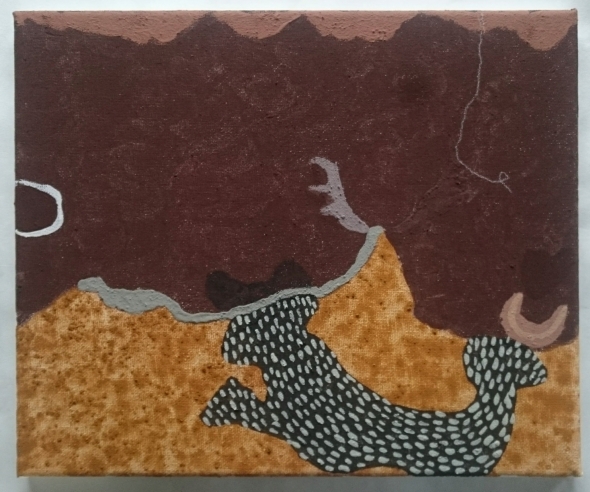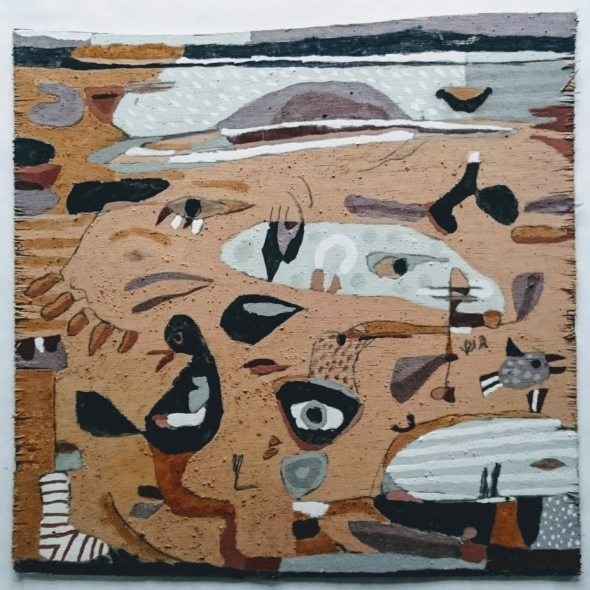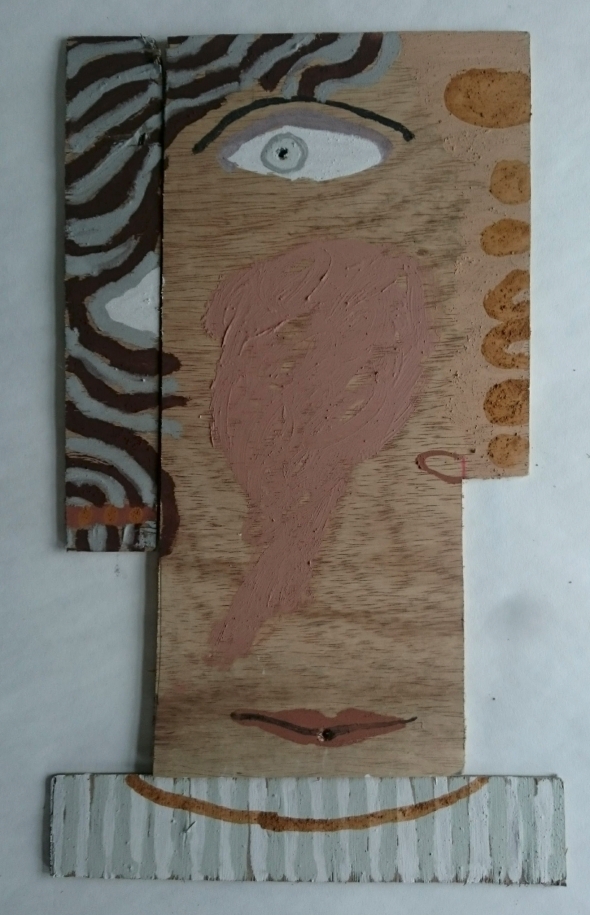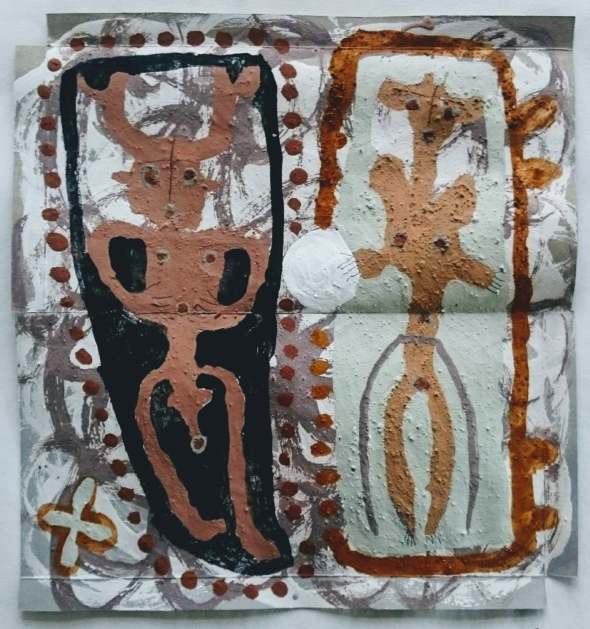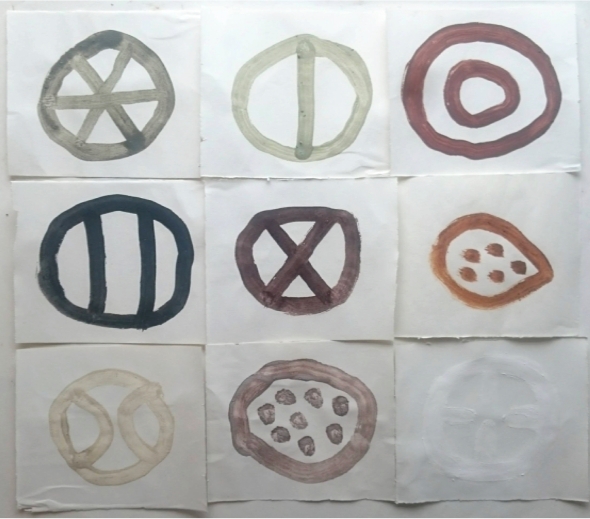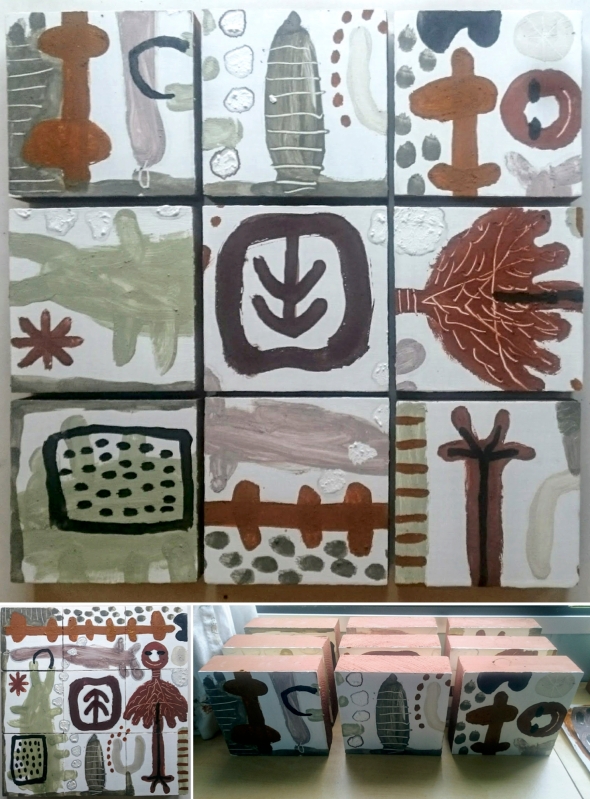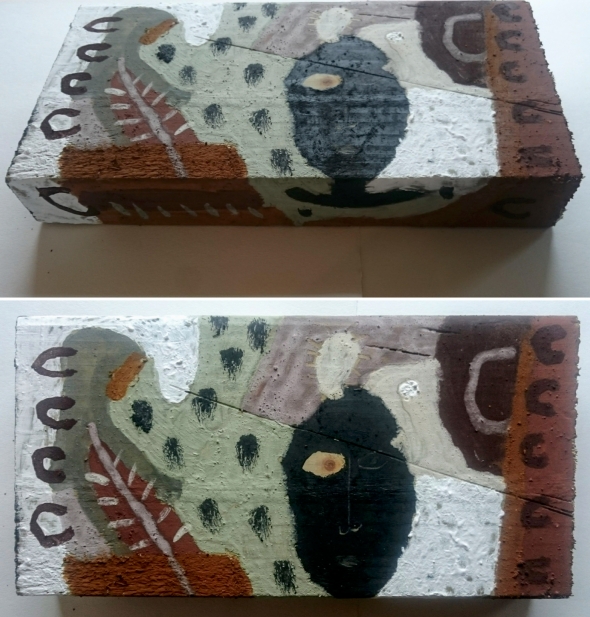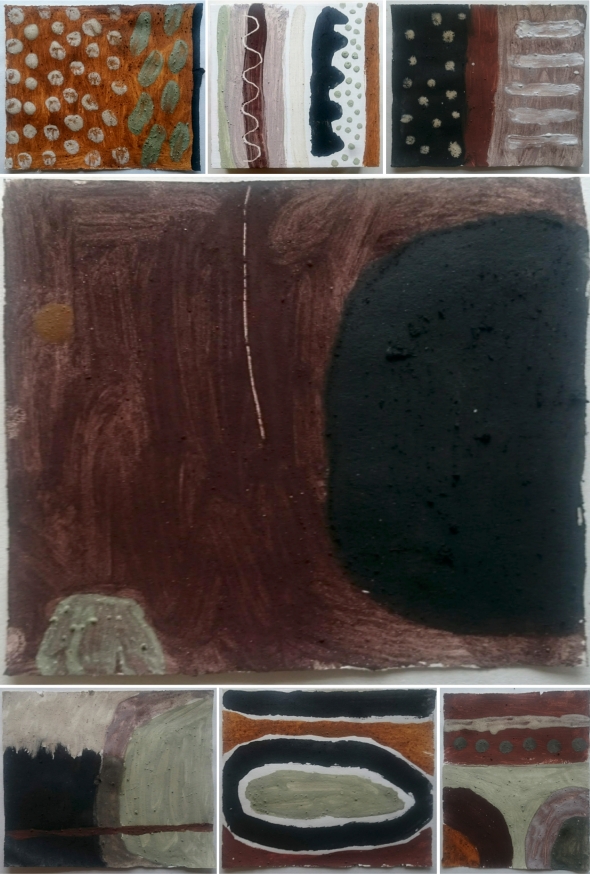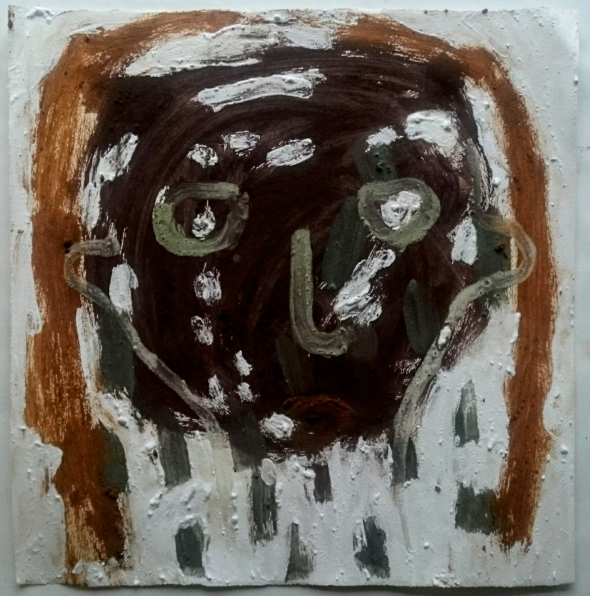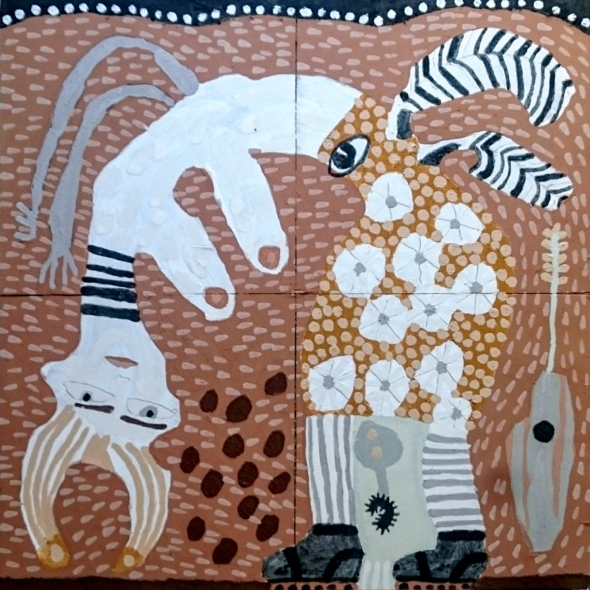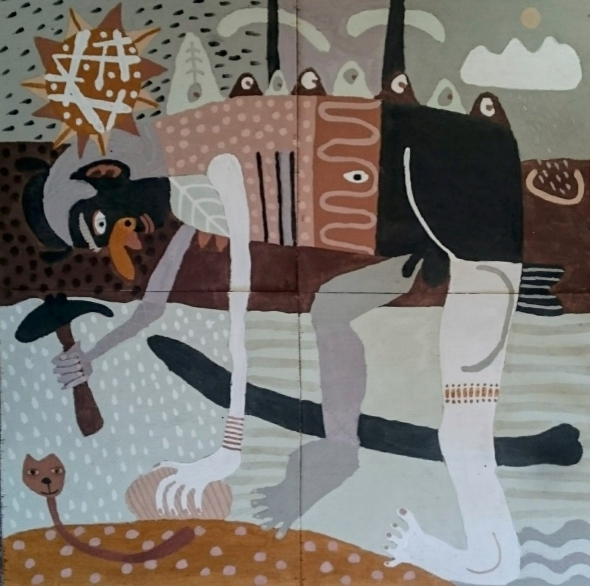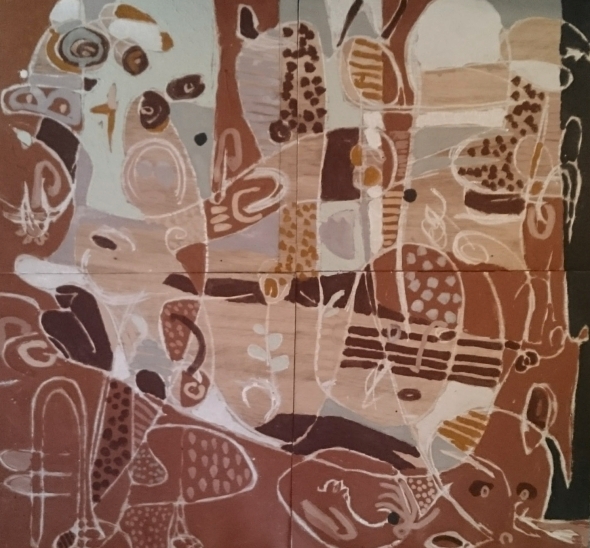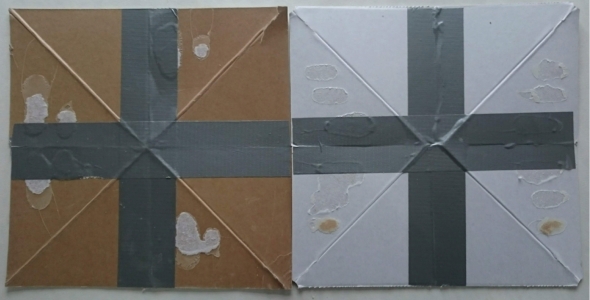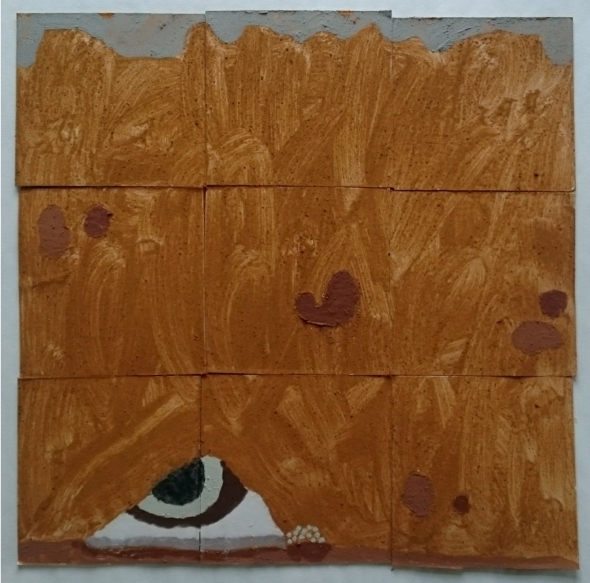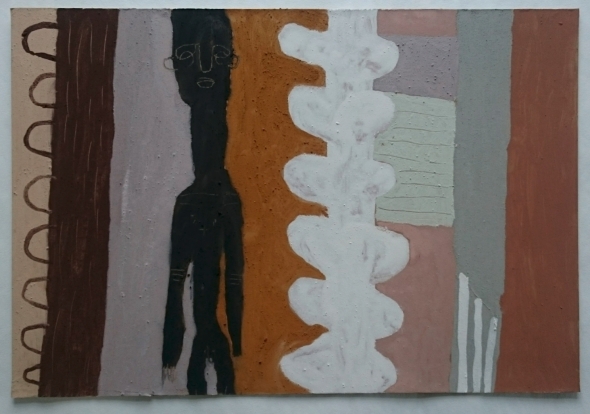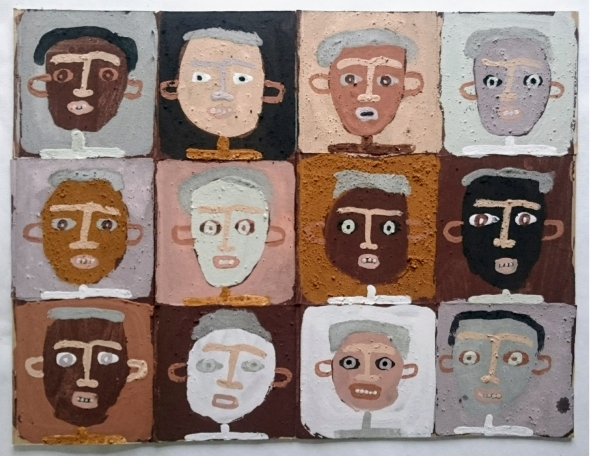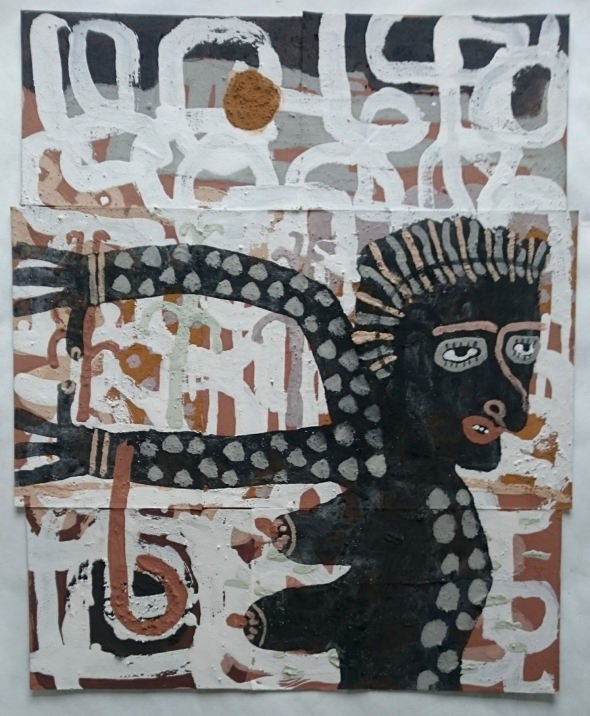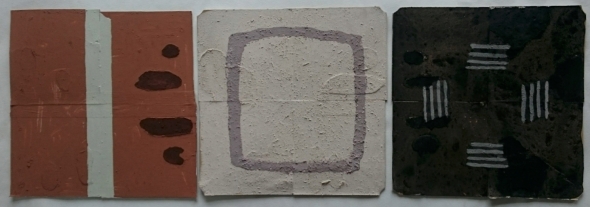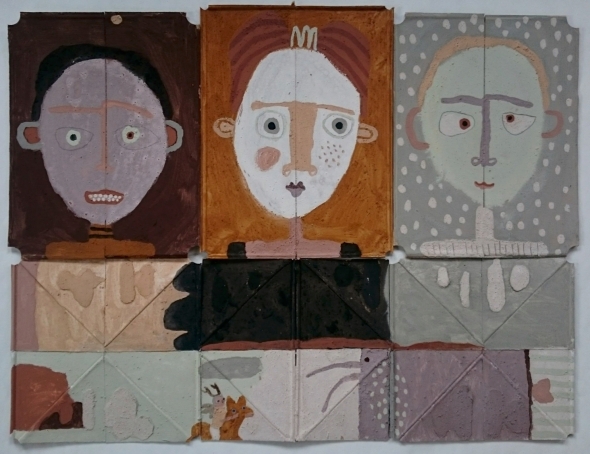no light no colour no more
Posted: February 25, 2019 Filed under: eARTh | Tags: Aesthetics, art and science, Arte Povera, Arts, arts research, Cornwall, earth pigments, eco art, ecopsychology, Environmental art, Feeling, indigenous culture, painting, Pigment, Visual arts 2 Commentsfurther material responses to existential emergence, crisis and change
I was reminded recently, while gazing fleetingly into the shimmering turquoise green blue ocean here in West Cornwall, of my early art training based in the classical understanding of colour. colour as light. a systematic mixing together of homogenous materials to represent the colours that we observe in Nature from a set of ‘primaries’: reds, blues and yellows. no black. white in moderation. of hue.
 iron board, Praa Sands, Cornwall (Cornish earth pigments on rock) © p ward 2019
iron board, Praa Sands, Cornwall (Cornish earth pigments on rock) © p ward 2019
our perception of colour, of light and shade, and hence of depth, size, form and materiality, is sometimes explained as the processing and communication of visual information created by the reflection, refraction and absorption of light in relation to materials. working with earth pigments has revealed ‘colour’ as more than just a visual ‘scientific’ process of perception. it is more a holistic appreciation of material presence which encompasses not just colour but texture, smell and a provenance of time and place, of formation and decay, of ecology, history and Nature itself.
we may often associate earth colours with a range of browns, reds and yellows. with this latest set of paintings I have been enjoying a more subtle selection of greys, greens, mauves and whites that I have found, gathered and mixed near my home.
I could say that the stories they tell are unique expressions of their own experience that I have been privileged to bring into contemporary form, but maybe that is for you to decide…
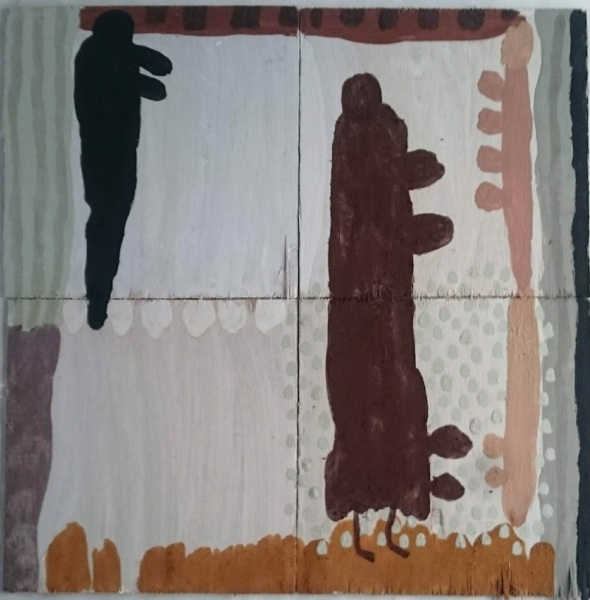 aspects of landscape and love – today it snowed (Cornish earth pigments on board; 51x51cm) © p ward 2019
aspects of landscape and love – today it snowed (Cornish earth pigments on board; 51x51cm) © p ward 2019
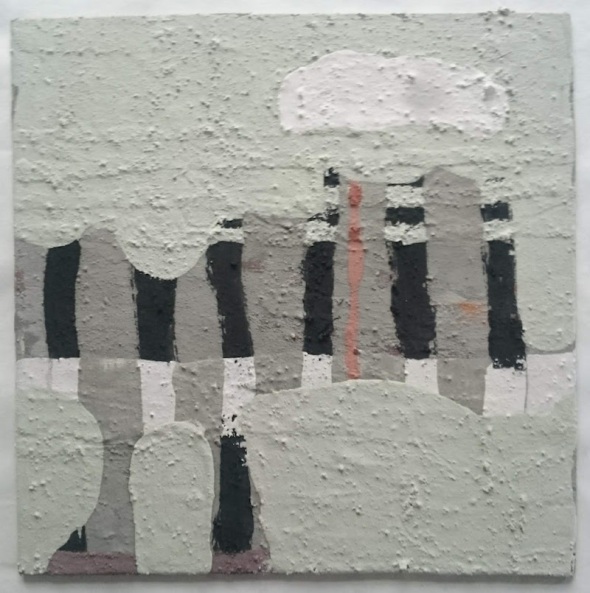 the beautiful things that people say when they are together (Cornish earth pigments on board; 25x25cm) © p ward 2019
the beautiful things that people say when they are together (Cornish earth pigments on board; 25x25cm) © p ward 2019
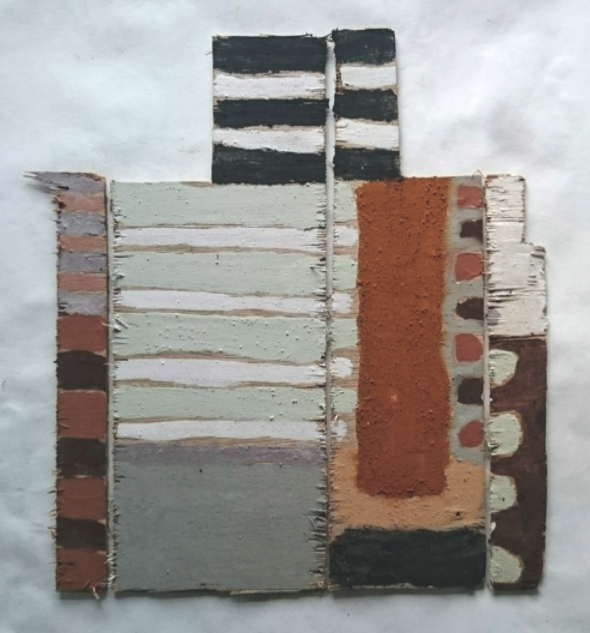 facing up to facing up to (Cornish earth pigments on board; 31x33cm) © p ward 2019
facing up to facing up to (Cornish earth pigments on board; 31x33cm) © p ward 2019
 rearranging the furniture (Cornish earth pigments on board; 35x35cm) © p ward 2019
rearranging the furniture (Cornish earth pigments on board; 35x35cm) © p ward 2019
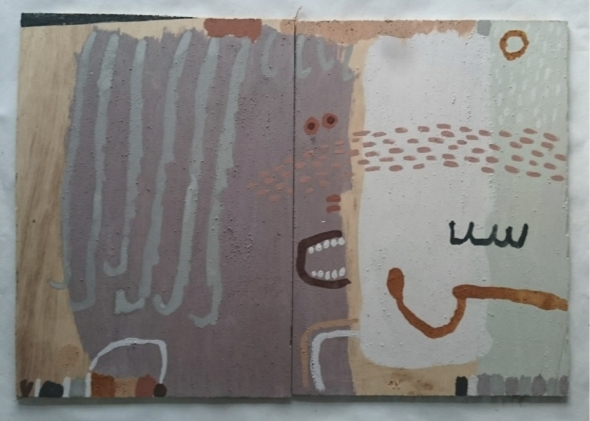 like chopping onions in a northwesterly gale (Cornish earth pigments on board; 56x38cm) © p ward 2019
like chopping onions in a northwesterly gale (Cornish earth pigments on board; 56x38cm) © p ward 2019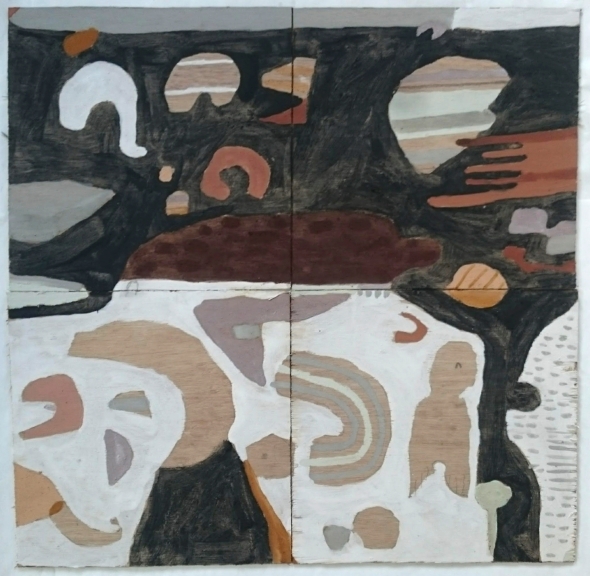 stones that stand in fields with swans and cows and geese: penwith (Cornish earth pigments on board; 70x68cm) © p ward 2019
stones that stand in fields with swans and cows and geese: penwith (Cornish earth pigments on board; 70x68cm) © p ward 2019
 simple communication here (Cornish earth pigments on card; 61x51cm) © p ward 2019
simple communication here (Cornish earth pigments on card; 61x51cm) © p ward 2019
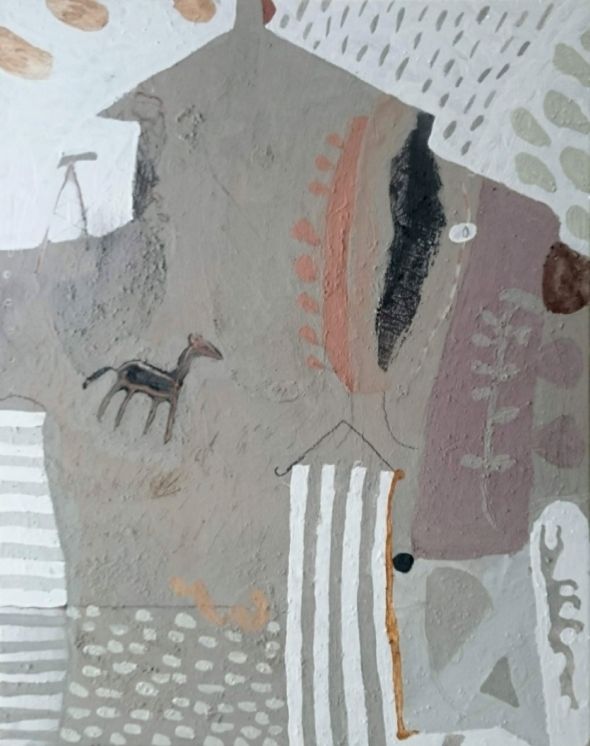 house of power (Cornish earth pigments on canvas; 40x50cm) © p ward 2019
house of power (Cornish earth pigments on canvas; 40x50cm) © p ward 2019
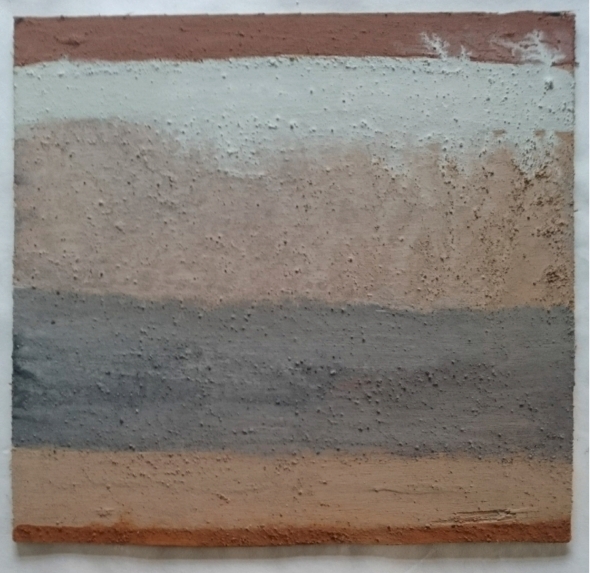 nondescript (Cornish earth pigments on board; 27x26cm) © p ward 2019
nondescript (Cornish earth pigments on board; 27x26cm) © p ward 2019
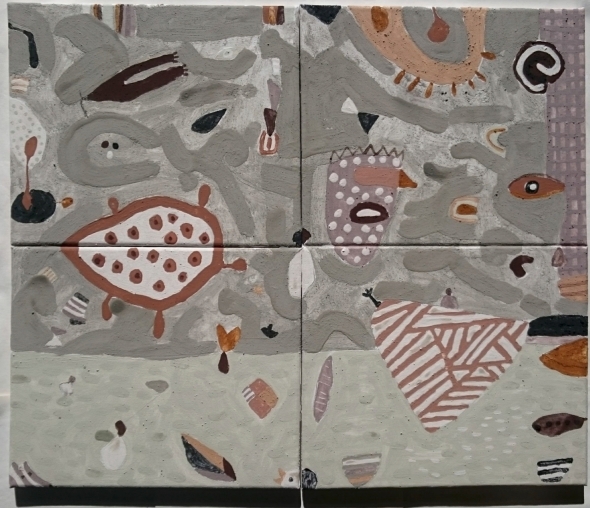 turning a new leaf with foxes on my mind (Cornish earth pigments on canvas; 61x51cm) © p ward 2019
turning a new leaf with foxes on my mind (Cornish earth pigments on canvas; 61x51cm) © p ward 2019
© P Ward 2019
painting within limits
Posted: January 26, 2019 Filed under: eARTh | Tags: Aesthetics, Arte Povera, Arts, arts research, Cornwall, Earth, earth pigments, eco art, ecopsychology, Environmental art, indigenous culture, painting, Pigment, Visual arts 1 Commentnew paintings from Cornwall – early 2019
For many years I have exclusively used colours from the earth in my paintings, gathering and processing all the pigments myself. Each location offers a unique palette and quality of colour to work with as well as a deeper understanding of that place.
To some it may seem as if creativity is being limited. “How can I paint the sky or the trees?” are frequent questions when running workshops. Working with earth pigments has changed the way I work and my understanding of painting in many ways. It has enriched my perception of colour and the ‘material’ of colour. Black is no longer “an absence of light”. For me it allows a specific expression of place orientated, of course, by my own relationship to being there.
The paintings here respond to the nature of earth colours and experiences in West Cornwall…
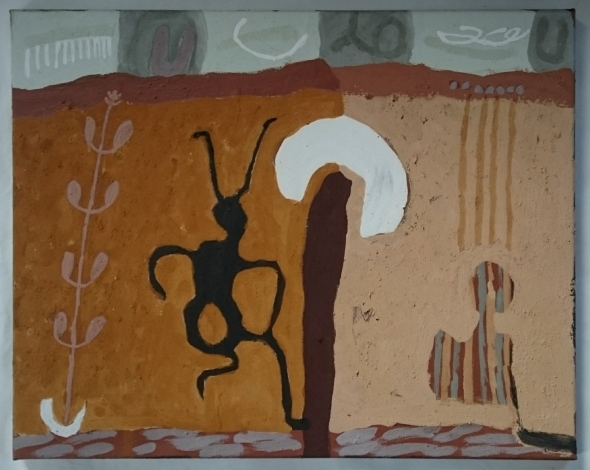 distance what we have become (Cornish earth pigments on canvas; 60x40cm) © p ward 2019
distance what we have become (Cornish earth pigments on canvas; 60x40cm) © p ward 2019
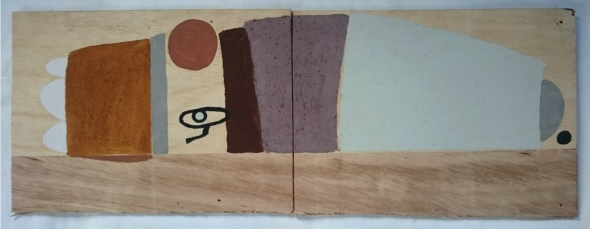 big red wolf moon that I did not see (Cornish earth pigments on board; 76x28cm) © p ward 2019
big red wolf moon that I did not see (Cornish earth pigments on board; 76x28cm) © p ward 2019
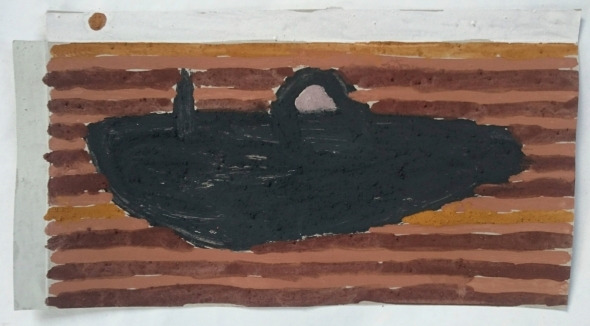 to run aground an island (Cornish earth pigments on card; 27x15cm) © p ward 2019
to run aground an island (Cornish earth pigments on card; 27x15cm) © p ward 2019
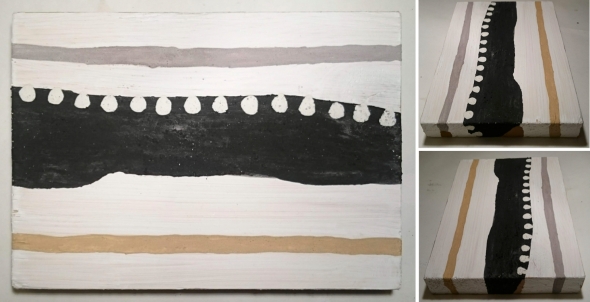 estuary (Cornish earth pigments on wood; 20×14.5x2cm) © p ward 2019
estuary (Cornish earth pigments on wood; 20×14.5x2cm) © p ward 2019
 untitled I, II, III (Cornish earth pigments on board; 25x26cm; 25x28cm; 25x26cm) © p ward 2019
untitled I, II, III (Cornish earth pigments on board; 25x26cm; 25x28cm; 25x26cm) © p ward 2019
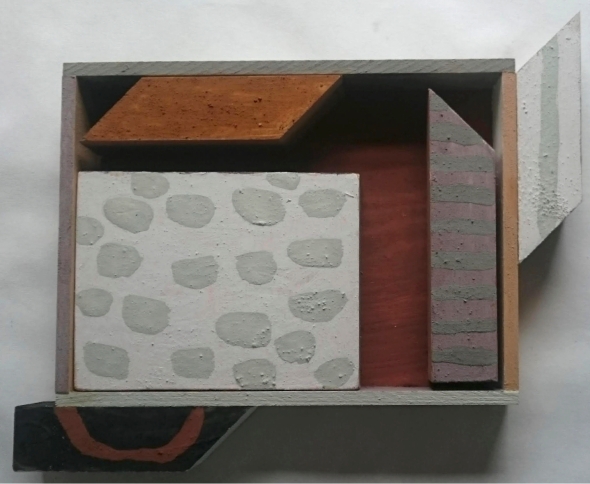 offcuts homestead (Cornish earth pigments on wood; 29x24x3cm) © p ward 2019
offcuts homestead (Cornish earth pigments on wood; 29x24x3cm) © p ward 2019
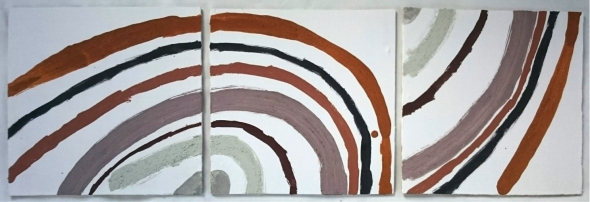 at fault (Cornish earth pigments on board; 80x26cm) © p ward 2019
at fault (Cornish earth pigments on board; 80x26cm) © p ward 2019
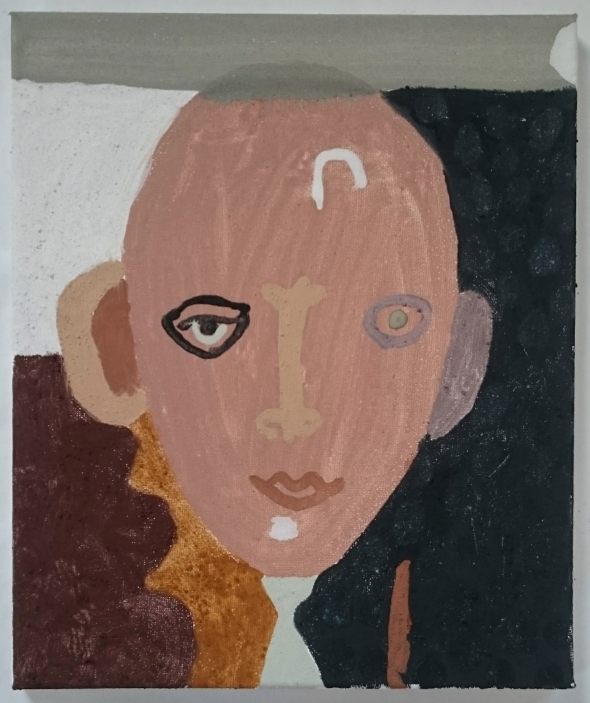 fairy queen (Cornish earth pigments on canvas; 25x30cm) © p ward 2019
fairy queen (Cornish earth pigments on canvas; 25x30cm) © p ward 2019
© P Ward 2019
ode to winter
Posted: January 25, 2019 Filed under: the ash tree | Tags: Cornwall, poetry, Prayer 1 CommentPenwith 2019
In darkness, I think of you
And in my thoughts
I cover you with flowers,
A multitude of colours, shapes and scents,
And remove them one by one
To reveal you anew
In beauty and in wonder.
May your world be full of light and joy,
Inspiration, warmth and love
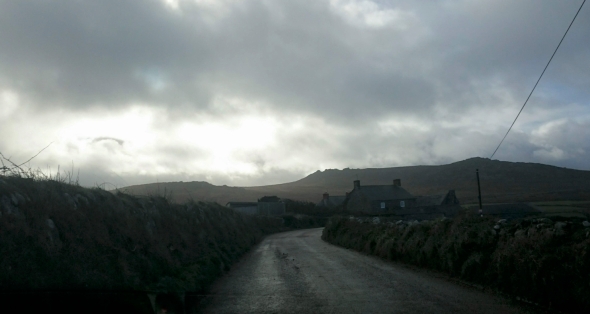 porthmeor farm, penwith © p ward 2019
porthmeor farm, penwith © p ward 2019
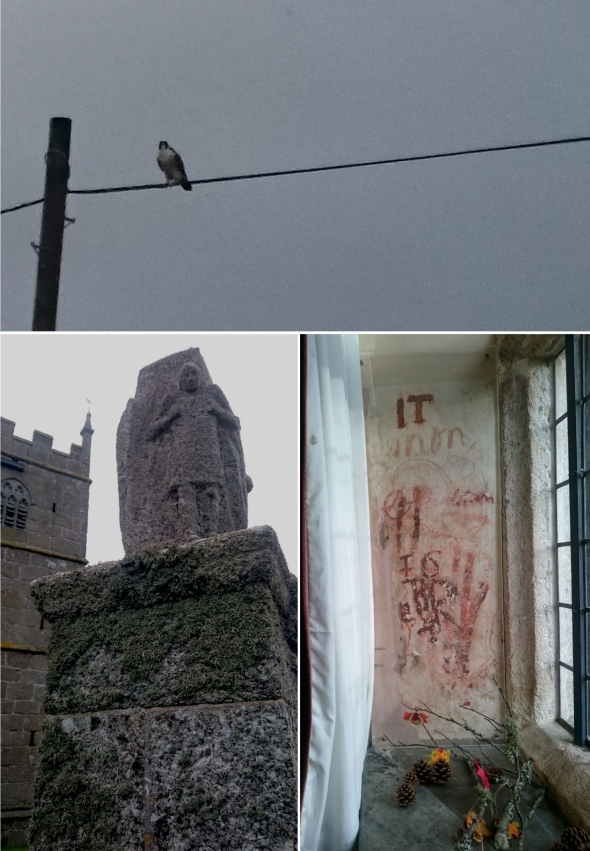 peregrine; zennor church; godolphin house, cornwall © p ward 2018
peregrine; zennor church; godolphin house, cornwall © p ward 2018
© P Ward 2019
Painting with Earth – Cornwall: new home, new works
Posted: November 30, 2018 Filed under: eARTh | Tags: Arte Povera, Arts, arts research, Cornwall, earth pigments, eco art, ecopsychology, Environmental art, Feeling, indigenous culture, painting, Pigment, poetry, Visual arts Leave a commentNovember 2018
despite the wind
despite the weather
despite the winter
despite the sense of vulnerability
this raw and new found exposure
despite the twisting and turmoil of our times
despite love
and loss
despite it all
this earth still shines
Before I embark on a new phase of experimentation, combining different binders with the Cornish pigments, I would like to share a few paintings that I have made in my new home – a caravan on a dairy farm in the coastal hills of west Penwith, Cornwall.
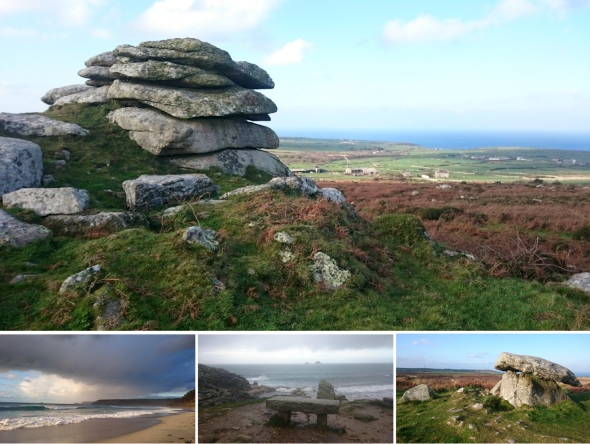 West Penwith, Cornwall – Morvah, Sennen Cove, Cot Valley and Chun Quoit © p ward 2018
West Penwith, Cornwall – Morvah, Sennen Cove, Cot Valley and Chun Quoit © p ward 2018
Here, I am surrounded by the historic land markings of the ancient peoples who populated this extremity of the British Isles. Stone walls, reportedly demarcating some of the oldest working field networks in the world, built 5000 years ago. Iron age hill forts, burial mounds, settlements and wells set in the denuded coastal wasteland of heath and moor. It is at times bleak. After the rain and wind that lashes fresh from the vast Atlantic ocean, the colours of autumn shine. The constantly changing hues of the blue and grey and turquoise sea. Rainbows sitting in our laps. The sky heavy and clear and dark and brooding. Salt water permeating. The animals are exposed by their hunt for food, by the lack of cover afforded by the stripped land. It is a place of spirit and history and life, right now.
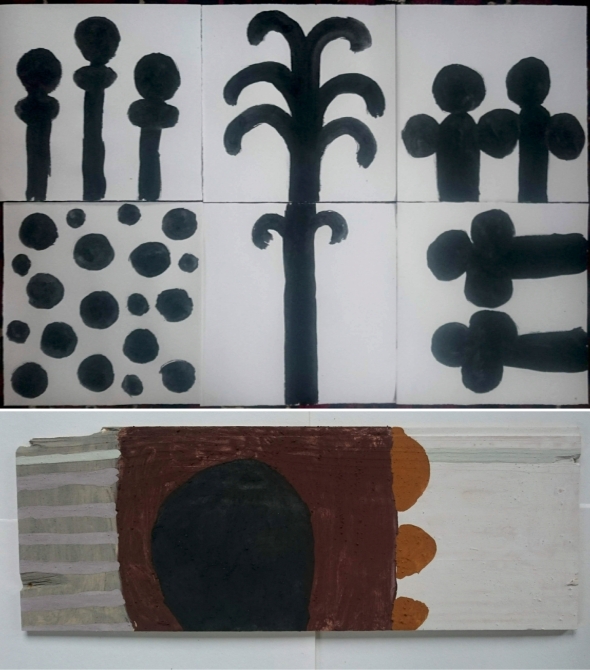 Penwith dream forms (Botallack black on paper); fogou (Cornish earth pigments on wood) © p ward 2018
Penwith dream forms (Botallack black on paper); fogou (Cornish earth pigments on wood) © p ward 2018
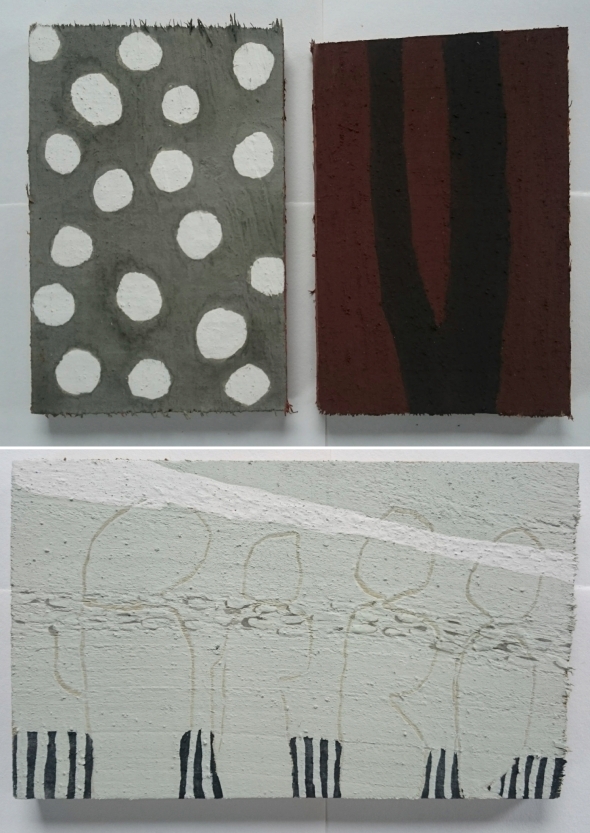 mineral, vegetable; mist (Cornish earth pigments on wood) © p ward 2018
mineral, vegetable; mist (Cornish earth pigments on wood) © p ward 2018
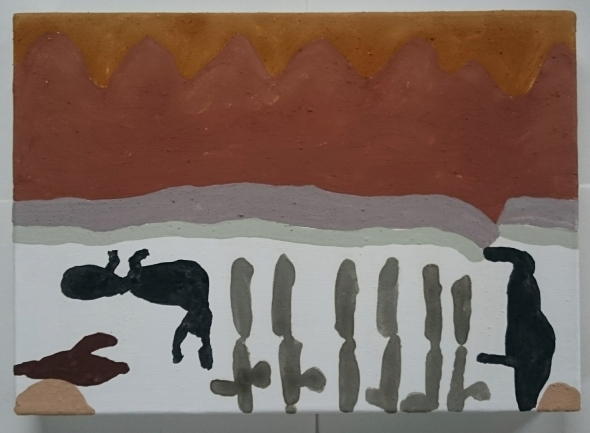 dance on the shore (Cornish earth pigments on canvas) © p ward 2018
dance on the shore (Cornish earth pigments on canvas) © p ward 2018
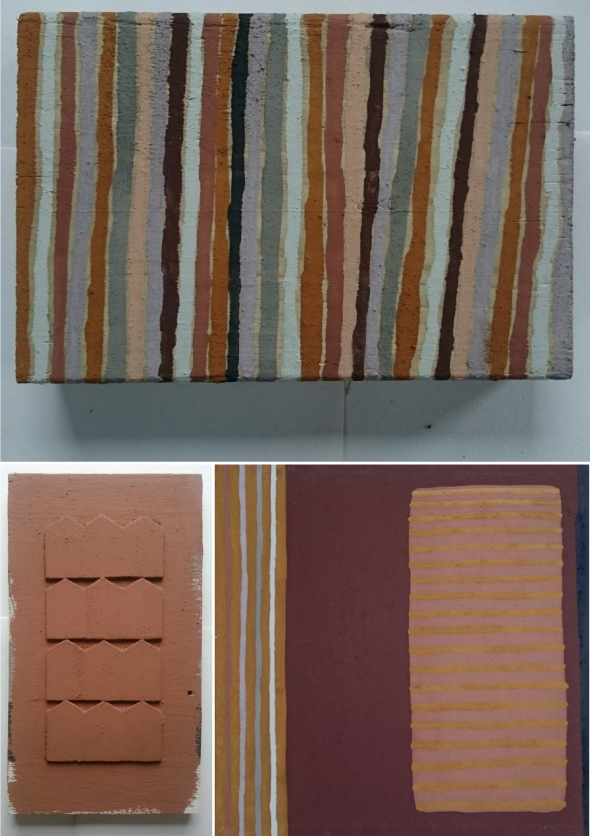 virtually vertical; community (Cornish earth pigments on wood); earth bound (Cornish earth pigments on canvas) © p ward 2018
virtually vertical; community (Cornish earth pigments on wood); earth bound (Cornish earth pigments on canvas) © p ward 2018
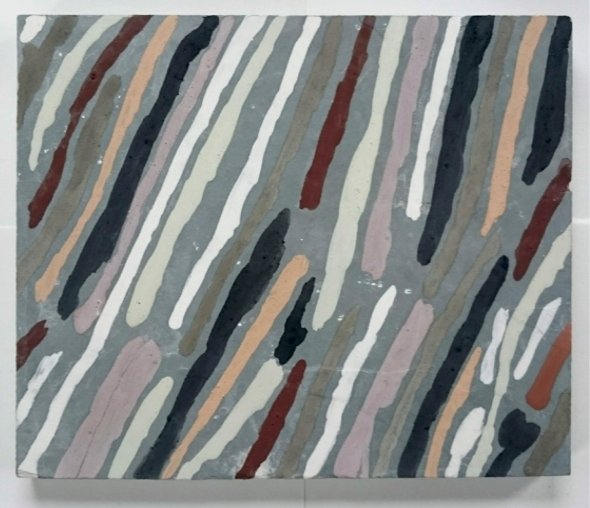 pigment drift (Cornish earth pigments on slate) © p ward 2018
pigment drift (Cornish earth pigments on slate) © p ward 2018
I am slowly learning to listen to the language of the colours here. The earth pigments, their qualities, their sources are unfamiliar. New to me. They are similar in colour to those of North Devon, that I have been using for a long time but very different in other ways. Their formation. Their nature. They have not been part of my own story, until now. The marks and stories they suggest are gradually revealing themselves. Their relationships unfolding. Their dynamic. And despite my attempts at integrity to their provenance and the spirit of this place in which I find myself, it is the freedom of my children’s paintings and drawings that are inspiring me…
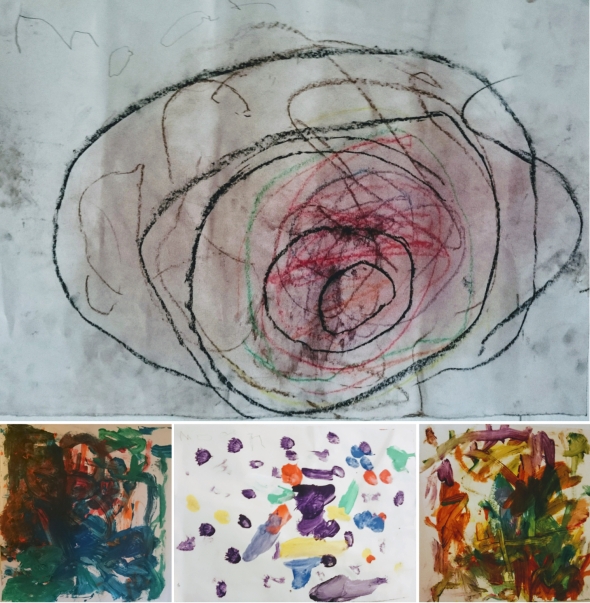 noah, agnes, noah, agnes (pastel and paint on paper) 2018
noah, agnes, noah, agnes (pastel and paint on paper) 2018
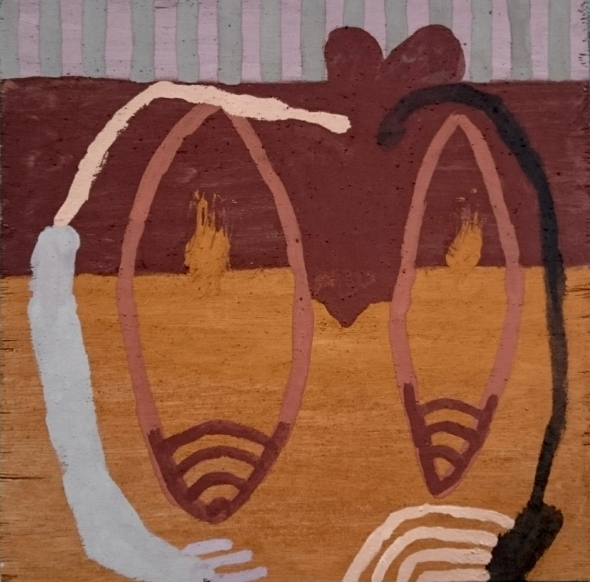 two heads (Cornish earth pigments on wood) © p ward 2018
two heads (Cornish earth pigments on wood) © p ward 2018
 eventual remediation (Cornish earth pigments on wood) © p ward 2018
eventual remediation (Cornish earth pigments on wood) © p ward 2018
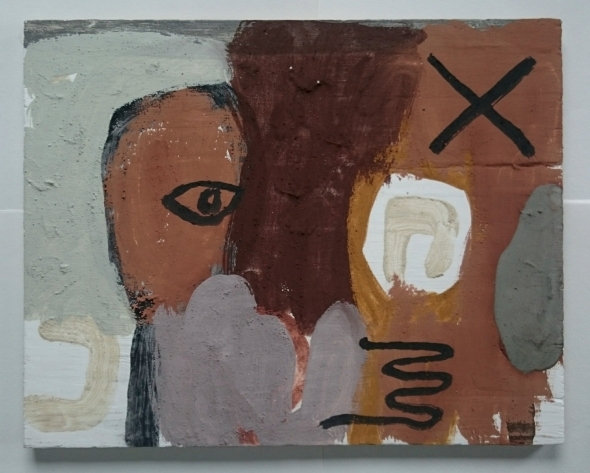 looking for love (Cornish earth pigments on wood) © p ward 2018
looking for love (Cornish earth pigments on wood) © p ward 2018
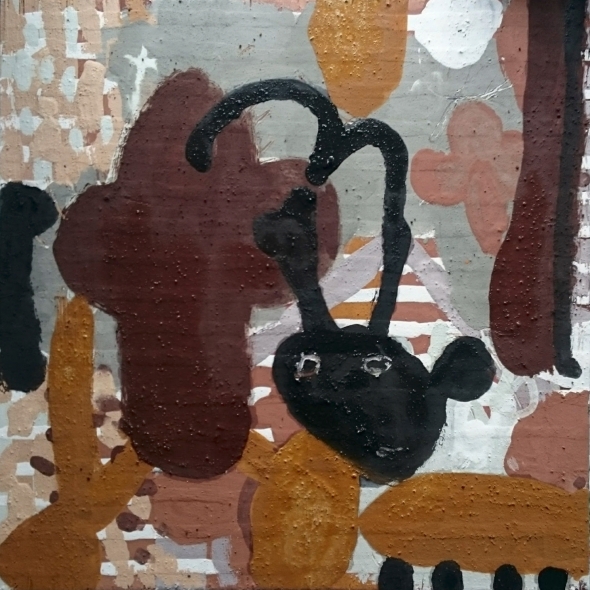 Cornish Folk Tale I (Cornish earth pigments on wood) © p ward 2018
Cornish Folk Tale I (Cornish earth pigments on wood) © p ward 2018
Professionally, I am working on an Arts Council National Lottery Project Fund proposal in association with Geevor Tin Mine to research the creative and educational potential of the pigments. Through recent projects and contact with the staff at the Mine I have started to appreciate and become really excited by the rich historical, geological, chemical and social provenance that the colours carry. After the far-reaching and ongoing success that Painting with Earth – North Devon has brought, let’s hope I will get some real financial support to enable the continuation of this rich seam of work ;-).
© P Ward 2018
painting a parish future – Pendeen in St Just, Cornwall
Posted: November 29, 2018 Filed under: activ8, eARTh, educ8 | Tags: arts research, Cornwall, earth pigments, eco art, Ecology, ecopsychology, Environmental art, indigenous culture, Interdisciplinarity, Mining, painting, Painting Together, Pigment, Visual arts 2 CommentsESRC Festival of Social Science, 10th November 2018
background
I met Dr Joanie Willett at a ‘Melting Pot’ event at Exeter University’s Environmental Sustainability Institute at Penryn Campus in Falmouth, Cornwall. The purpose of the event was to provide opportunities for cross-disciplinary collaborations. Dr Willett was fascinated by aspects of the geology behind earth pigments, particularly of those connected with mining waste, and of the potential for public engagement that my workshops provided. I was intrigued by Dr Willett’s studies around Parish Councils and how to promote public engagement in the political process, reminding me of conversations I had in Australia around the ecological basis of Aboriginal tribal councils.
After a further meeting, held as a walk along the ‘Tin Coast’ in West Penwith between Pendeen and Botallack, we decided to organize a public workshop exploring these principles. Funding was obtained from the Economic and Social Research Council and Exeter University as part of the Festival of Social Science, a national event making Social research accessible to the general public.
where the personal becomes POLITICAL: the idea
Our personal experiences, knowledge and perceptions of the places we live are all valid contributory factors to the cultural truth of a place. In Western democracies the starting point for policy decisions are ideally based in such cultural truths. Parish councils, of which there are some 10,000 in the UK, are the gathering places for the diverse cultural perception of our local communities. Beyond this such cultural perceptions are strongly influenced, if not determined, by the geographical identity, the physical ecology and resources, of a place.
painting a parish future offers a creative space to cultivate and share personal experience, knowledge and future visions of the places that we live.
It is hoped that the creation of such a space within a working Parish may encourage a spirit of commonality and cooperation within groups that may too easily become competitive and detached from the truth of a regions imminent ecology, in respect of all its inhabitants.
painting a parish futureis a collaborative research project led by politics lecturer Dr Joanie Willett and ecological artist Peter Ward in association with Exeter University’s Environmental Sustainability Institute. The project will utilize a shared knowledge of local political process and creative environmental engagement.
An initial enquiry will gather local people, parish councilors and experts to walk and share experiences and knowledge in a reflective process in the Parish of St Just in west Cornwall. The daylong event will culminate in a communal painting using gathered materials to express a shared vision of the future. The painting and further documentation of the event will be exhibited at the ESI at Penryn Campus and at a local venue in St Just Parish.
painting a parish futurewill run alongside ongoing national and local initiatives ‘Going Wild’ with Cornwall Council and the Cornwall Wildlife Trust and the St Just and Pendeen Neighbourhood Development Plan.
The project will provide a model for further actions in local communities across the UK, international research with Indigenous communities in Australia and the basis for an academic paper in relation to such activities, as well as a real focus for community action in the place it is performed.
in practice
The event was advertised locally in the Parish ‘Outreach’ magazine, through flyers in local shops and on notice boards and through personal invitation to relevant experts. It was hoped that we would have a group of about 20 people for the event. In practice, we were fortunate that a County Councilor expressed her interest from an early stage, inviting a simple presentation at a Town Council meeting in St Just to further promote the event. On the day, 2 people who had signed up did not show leaving us with a group of 7, including Dr Willett and myself. While the response was a little disappointing, and indeed raised a very important discussion regarding public engagement, the small number did allow for more focused time and intimate space for discussion and sharing and better engagement with the process.
Part of my personal motivation for the event was to begin to learn more about the place that I live. Both my own background research about the area and the process of organizing the event provided interesting insights into the present social dynamic and historical roots of the parish. Another part was to establish contacts within the community and with relevant organizations for future projects.
 Poster/invitation for painting a parish future – Pendeen in St Just; 7 Cornish pigments, earth colours used in communal painting © p ward 2018
Poster/invitation for painting a parish future – Pendeen in St Just; 7 Cornish pigments, earth colours used in communal painting © p ward 2018
Participants included an artist, a politics lecturer, an environmental educator and project manager, a childminder, County Councilor, Town Councilor and a geologist, providing the basis for lively, diverse and informed discussion throughout the day with many thoughts for positive action being shared.
The morning walk took us through the village of Pendeen to the recently restored leat (a community project initiated by a member of the group), through the historic mining community of Lower Boscaswell, to the medieval ‘holy’ well and then through remains of Geevor Tin Mine and ancient field networks down to the coast, before heading back to the Parish Hall for lunch. Conversation within the group flowed easily between the whole group and individuals and covered topics from local planning policy, local history and geology, the influence of the environment on agriculture, national environmental and political attitudes, interspersed with a shared appreciation of the natural world, and in particular the local environment. Lunch was a homemade vegetable soup, made using exclusively local produce from the community farm, along with local cheese and bread and a splendid array of cake.
Pendeen Parish Hall, photo courtesy J Willett
The process of painting (interesting for my part for the lack of ‘artists’ in the group) took participants a little out of their comfort zones but allowed us to ground our thoughts in a meaningful and enjoyable way. The pigments themselves offered further insights into the local environment, as well as paint making. The painting itself was structured through an approximation of the evolutionary process, starting with imagery around geology, then land use and flora and fauna and lastly human intervention. Despite the initial discomfort, participants recognized the value of the process, at whatever level individuals felt able to contribute, and enjoyed the end result.
painting a parish future – Pendeen in St Just, photos courtesy J Willett and M Ward
conclusion and further action
Despite the somewhat disappointing public response to the event, it was agreed that it had been a useful and inspiring day with everyone feeling they would use what they had learnt in some way. Some said they ‘had never participated in anything like it before’ and that it had revealed a new way of working in the public sphere. I was personally encouraged by how everyone got involved with the process and in particular how the act of painting with local pigments was enjoyed and valued.
As a facilitator, whenever I approach an event such as this I will necessarily fill my mind with any relevant information I wish to share and a structure I aim to run the day through. In practice, especially when working with adults, it is essential that such plans are held merely as guidelines and that the process and dynamic of the group are allowed to express themselves for a satisfactory outcome to be achieved. Indeed, it is inherent to the process that the day is allowed to progress organically within any practical limitations, such as time, space, numbers and sustenance, to be true to itself. What is exciting about such a process is exactly those surprises or unknowns that arise, leading us to new ideas and future actions.
Through contacts made at the Town Council presentation, it is hoped that the painting and research will be exhibited at St Just Library, while also being shared with the Town Council and Local Neighbourhood Development Plan as an example of public engagement. Discussion has already begun regarding further collaboration with Dr Willett with the possibility of developing the event in other areas. Business and public groups in the area have also approached me to run similar workshops for upcoming events.
painting a parish future– Pendeen in St Just, communal painting, earth pigments on board © p ward 2018
Thank you to everyone who participated in the event, for the support and interest of the local community and especially to Joanie for her contributions and collaborative insights.
© P Ward 2018
burnt CARN
Posted: August 31, 2018 Filed under: A BUNDLE OF STICKS, the ash tree | Tags: arts research, Cornwall, Cornwall Area of Outstanding Beauty, Ecology, ecopsychology, Environmental art, Feeling, poetry Leave a commentPendeen, Cornwall 190818
a howling man dressed in black set fire to the hill (carn) behind Pendeen…
 burnt CARN, Pendeen, Cornwall 190818 I-III © p ward 2018
burnt CARN, Pendeen, Cornwall 190818 I-III © p ward 2018
 burnt CARN, Pendeen, Cornwall 190818 IV-IX © p ward 2018
burnt CARN, Pendeen, Cornwall 190818 IV-IX © p ward 2018
 burnt CARN, Pendeen, Cornwall 190818 X © p ward 2018
burnt CARN, Pendeen, Cornwall 190818 X © p ward 2018
 burnt CARN, Pendeen, Cornwall 190818 XI © p ward 2018
burnt CARN, Pendeen, Cornwall 190818 XI © p ward 2018
it has been a while since I have felt watched,
since I have felt the company of an-other.
the scent of burnt earth
forms distorted by fire
a thick sea mist blowing through the hilltop
silence…
© P Ward 2018
7 Cornish Pigments: first findings
Posted: August 31, 2018 Filed under: eARTh, educ8 | Tags: art and science, Arte Povera, arts research, British Art, Cornish Art, Cornish mining, Cornwall, earth pigments, eco art, Ecology, ecopsychology, Environmental art, Interdisciplinarity, Mining 1 CommentTHIS TOXIC(?) BEAUTY
 Cornish Landscape (raw and ground Cornish pigments) © p ward 2018
Cornish Landscape (raw and ground Cornish pigments) © p ward 2018
The 7 colours shown here have been gathered close to historic mining sites in west Cornwall. Some are waste products from tin and copper mining and may contain toxic minerals such as arsenic and cadmium, ironically both used historically in paint and pigment production. Despite being found alongside public rights of way until sufficient mineral analysis has been made of the samples I am unable to share them with the public.
However, I am comfortable enough to start using them myself (with care). Inspired by the milling process used to extract tin I have started to mix the raw materials with water before filtering with a fine sieve. This minimizes the grinding process and hence the possible inhalation of dust. So far I have only used PVA glue as a binder but enjoyed the difference in colour, provenance and nature of the pigments compared to the North Devon pigments I am more familiar with. As such the imagery has started to take on its own character relevant to the materials, the geographical space and my personal experience of Penwith and west Cornwall. I am currently working with Geevor Tin Mine Museum to develop educational workshops using the pigments. The mine itself and attendant museum is utterly fascinating allowing me to better understand the differences between pigments from natural landforms and those extracted from deep underground. In due time I will be able to better share my findings but for the time being here are some of my first paintings made using the wonderful, beautiful but maybe a little toxic Cornish pigments.
As yet the paintings are relatively small (up to 60x60cm) but I look forward to taking some of these ideas to a larger scale and context. If you are interested in any of the work shown here or would like to support or contribute to any further research please get in touch.
 7 Cornish pigments – paint samples on paper @ p ward 2018
7 Cornish pigments – paint samples on paper @ p ward 2018
 Cornish Quilt (Cornish earth pigments on paper) © p ward 2018
Cornish Quilt (Cornish earth pigments on paper) © p ward 2018
 6x6x6 (Cornish earth pigments on paper) © p ward 2018
6x6x6 (Cornish earth pigments on paper) © p ward 2018
 red, grey, green (Cornish earth pigments on paper) © p ward 2018
red, grey, green (Cornish earth pigments on paper) © p ward 2018
 grey, green, white, mauve I-III (Cornish earth pigments on wood) © p ward 2018
grey, green, white, mauve I-III (Cornish earth pigments on wood) © p ward 2018
 fox walking (Cornish earth pigments on wood) © p ward 2018
fox walking (Cornish earth pigments on wood) © p ward 2018
 dagdu (Cornish earth pigments on board) © p ward 2018
dagdu (Cornish earth pigments on board) © p ward 2018
 in landscape I-V (Cornish earth pigments on paper) © p ward 2018
in landscape I-V (Cornish earth pigments on paper) © p ward 2018
 botallack black – arches, obliterate, behind a rainbow (Cornish earth pigments on paper) © p ward 2018
botallack black – arches, obliterate, behind a rainbow (Cornish earth pigments on paper) © p ward 2018
 vertical palette (Cornish earth pigments on board) © p ward 2018
vertical palette (Cornish earth pigments on board) © p ward 2018
 untitled – explorations in colour and form I-IV (Cornish earth pigments on board) © p ward 2018
untitled – explorations in colour and form I-IV (Cornish earth pigments on board) © p ward 2018
 falling (Cornish earth pigments on board) © p ward 2018
falling (Cornish earth pigments on board) © p ward 2018
 in relationship I-III (Cornish earth pigments on board) © p ward 2018
in relationship I-III (Cornish earth pigments on board) © p ward 2018
 in relationship – butterfly (Cornish earth pigments on canvas) © p ward 2018
in relationship – butterfly (Cornish earth pigments on canvas) © p ward 2018
 storyteller IV (Cornish earth pigments on canvas) © p ward 2018
storyteller IV (Cornish earth pigments on canvas) © p ward 2018
 bird box (Cornish earth pigments on wood) © p ward 2018
bird box (Cornish earth pigments on wood) © p ward 2018
 4 vertical colours (Cornish earth pigments on board) © p ward 2018
4 vertical colours (Cornish earth pigments on board) © p ward 2018
 sketch I and II (Cornish earth pigments on paper) © p ward 2018
sketch I and II (Cornish earth pigments on paper) © p ward 2018
 house on wheels – sketch (Cornish earth pigments on paper) © p ward 2018
house on wheels – sketch (Cornish earth pigments on paper) © p ward 2018
With thanks to the people and places of west Cornwall. In particular, the staff of Geevor Tin Mine, Fiona, Natasha and of course Francesca and family for your inspiration and support.
© P Ward 2018
new home new earth
Posted: February 5, 2018 Filed under: eARTh | Tags: Art, Arte Povera, Arts, arts research, Cornwall, Cornwall Area of Outstanding Beauty, earth pigments, eco art, Ecology, Environmental art, Geevor Mine, Levant Mine, Mining, Pigment, Visual arts, West Penwith 2 Commentsdiscovering colour in west cornwall
 Pendeen, Trewellard, Boscaswell and Geevor Mine, Cornwall © p ward 2018
Pendeen, Trewellard, Boscaswell and Geevor Mine, Cornwall © p ward 2018
moving home is always an exciting (if not somewhat stressful) time for discovery, for exploration, for new knowledge and for refreshment of life paths. I have recently moved with my family from North Devon to West Cornwall, as far south and west as one can go in the British Isles (apart from the Isles of Scilly, of course). The move was made to connect with the flourishing and historic arts scene in the area – Newlyn and St Ives on the Penwith peninsula being significant places in British art history over the last few centuries. The area is also remarkable for the globally significant tin and copper mining industries that flourished during the nineteenth century providing a wealth of metal ores and new technologies that contributed to mining knowledge around the world. The industry has now all but died out, due to cheaper sources elsewhere, but has left its mark ecologically and architecturally to this rugged, wet and windy section of Atlantic coast.
 Sennen Cove, Cornwall © p ward 2018
Sennen Cove, Cornwall © p ward 2018
 Rainbow over Geevor Mine, Cornwall © p ward 2018
Rainbow over Geevor Mine, Cornwall © p ward 2018
 Phone Box collection, Trewellard, Cornwall © p ward 2018
Phone Box collection, Trewellard, Cornwall © p ward 2018
 Lamppost, Pendeen, Cornwall © p ward 2018
Lamppost, Pendeen, Cornwall © p ward 2018
 Leswidden block works, St Just, Cornwall © p ward 2018
Leswidden block works, St Just, Cornwall © p ward 2018
 ‘Montol’ Midwinter celebrations, Penzance, Cornwall © p ward 2018
‘Montol’ Midwinter celebrations, Penzance, Cornwall © p ward 2018
 Turning on the Mousehole Lights, Cornwall © p ward 2018
Turning on the Mousehole Lights, Cornwall © p ward 2018
having spent the last ten years intensively researching the geology, history and uses of earth pigments found in North Devon, and establishing an international reputation through it, it is quite nerve wracking to up sticks and start again. Added to this sense of newness, is that of the unfamiliar. North Devon is my mother’s family home and a region I have known all my life. While the wild and austere beauty of West Penwith is visually and culturally inspiring it will be a while before I feel it as my home, despite feeling very comfortable here, nestled in a cosy old granite cottage close to the north coast. However, the process of taking root has begun and exploration to reveal the individual peculiarities of my new home, and especially those qualities that appeal to my own nature, have gripped my thoughts and actions.
 Lanyon’s Quoit, Penwith, Cornwall © p ward 2018
Lanyon’s Quoit, Penwith, Cornwall © p ward 2018
 Merry Maidens stone circle, Penwith, Cornwall © p ward 2018
Merry Maidens stone circle, Penwith, Cornwall © p ward 2018
 Lanyon’s Quoit in the mist, Penwith, Cornwall © p ward 2018
Lanyon’s Quoit in the mist, Penwith, Cornwall © p ward 2018
within six weeks we have found four excellent and bold earth colours locally, associated with historic mining activities. We have revealed a dolmen in our living room as well as starting to visit the plethora of ancient megalithic sites in the area. The sea, the mist, the rocks and wind are ever present on this extreme peninsula, the most exposed place I have ever lived. Having studied for my MA in Falmouth and consequently visited the county on numerous occasions, I am vaguely familiar with the area and some of the sites of interest, but was unaware of the incredible natural and cultural richness it provides. The county of Cornwall is one of the few Celtic strongholds on the British Isles, with its own language and a pride in its unique history, both ancient and modern. This is evident in so many ways – its folklore, place names, wildlife, art and its connection to the sea and land. I am very excited to see how this feeds my own creative output.
 Levant mine entrance, Cornwall © p ward 2018
Levant mine entrance, Cornwall © p ward 2018
 Red ‘clay’ at Geevor Tin Mine, Cornwall © p ward 2018
Red ‘clay’ at Geevor Tin Mine, Cornwall © p ward 2018
 Bottallack Mines, Cornwall © p ward 2018
Bottallack Mines, Cornwall © p ward 2018
 Purple and red ‘clays’ at Levant Mine, Cornwall © p ward 2018
Purple and red ‘clays’ at Levant Mine, Cornwall © p ward 2018
 Leswidden China Clay Pits, nr St Just, and Spoil heaps at Tywarnhayle Mine, Porthtowan, Cornwall © p ward 2018
Leswidden China Clay Pits, nr St Just, and Spoil heaps at Tywarnhayle Mine, Porthtowan, Cornwall © p ward 2018
the pigments we have gathered so far include red and purple ‘clays’, residues from the slag heaps at Levant Tin Mine, apparently deposited alongside, and hence coloured by oxides within, the seams of black tin (casserite) found in cracks in the 340 million year old granite mass that forms the majority of landmass here. The huge forces, pressures and temperatures experienced as the molten granite forced its way through weaknesses in the overlying Devonian sediment created a wealth of opportunities for metallic minerals ores to form alongside metamorphic rocks. According to one source the area has some of the most varied and mineral rich geologies in the world! We have collected a yellow ochre-like residue from mine waste heaps further northeast at Tywarnhayle Mine, Porthtowan. The yellow deposit also contains fragments of ‘green’ rock that will be interesting to separate and hopefully use. The oldest China Clay pits, formed in lakes as eroded granite deposits, can also be found near St Just in Penwith with a wealth of local history and national significance. We have been given access to this beautiful smooth white clay by the present landowner, whose father spent some time working in the drying kilns on site during his youth. We are experimenting with different approaches to processing the raw pigments, relying on water extraction, sieving and drying, similar to historic methods of extracting ore, rather than the more physical drying and grinding that we employed with the very different pigments in North Devon. This is partly due to the different nature of the raw pigments but also as a safeguard against inhaling potentially dangerous bi-products of the mining residues, such as arsenic! We are presently seeking geologists to aid in our research.
 shapes, marks, patterns and forms, Cornwall © p ward 2018
shapes, marks, patterns and forms, Cornwall © p ward 2018
 textures and marks, Penwith, Cornwall © p ward 2018
textures and marks, Penwith, Cornwall © p ward 2018
As you can see, it’s all really exciting stuff. However, as yet, we are still to find a suitable workspace, tubs of pigment being stored and worked on convenient window ledges and in the cramped garden shed. But time will work its magic and the right space will reveal itself. We have already been made aware of a possible arts space development in old buildings at the entrance to the mining museum at Geevor mine in our village, as well as studio spaces associated with the established art schools of St Ives and Newlyn. Work still continues elsewhere too with talks and workshops coming up in North Devon and further afield in East Sussex, so all is good with the world. And all this while juggling childcare priorities and other homemaking eventualities. So, thank you to family and friends for your support during our transition and also to the warm welcome and help we have received from the local community. I am certainly looking forward to seeing how everything unfolds…
 Geevor Tin Mine, Cornwall © p ward 2018
Geevor Tin Mine, Cornwall © p ward 2018
 Levant Mine, Cornwall © p ward 2018
Levant Mine, Cornwall © p ward 2018
 Geevor and Levant mines, Penwith Heritage Coast, Cornwall © p ward 2018
Geevor and Levant mines, Penwith Heritage Coast, Cornwall © p ward 2018
© P Ward 2018
Digging in the Dirt
Posted: February 13, 2013 Filed under: activ8, eARTh, Uncategorized | Tags: Aesthetics, Ancient woodland, arts research, Cornwall, earth pigments, eco art, Ecology, Environmental art, Godrevy Bay, indigenous culture, Interdisciplinarity, Nature, Prayer, Ritual, Tehidy Woods, Visual arts, Woodland Leave a commentstill working (together) to unearth a sense of ecologic expression
Despite prolonged respite from the imbalance of intellectual restraint and academic conceptualisation it is with some regret we must announce that this most personable aesthetic conversation is struggling to reveal the treasures that such shared passions have promised. It is certainly not a matter of lack of talent, or lack of desire for that matter – we have bucket loads of both. Nor is it through misunderstanding or dishonest perception of our circumstantial condition – we can see our world with all four eyes, looking outside and in. But practically speaking the economic, or at least financial climate within which we currently reside, and our own malingering downtrodden sense of poverty has temporarily overwhelmed any sense of optimism that henceforth breathed and pulsed within our eloquent evocations of spirit and love…
 tehidy woods, north cornwall (p ward 2013)
tehidy woods, north cornwall (p ward 2013)
So then what shall we do, if not buckle beneath the oppressive dominance of capital and self-imposed slavery and familial media negativity? We shall dig in the dirt and walk in the rain and relish decay and be awestruck by beauty and age and kick shit in the faces of those who would wish us ill through greed, ignorance, pity and petty law making.
 tehidy woods, north cornwall (p ward 2013)
tehidy woods, north cornwall (p ward 2013)
We touch the earth and sense the power that is held within.
We hold the earth and listen to the wisdom of its age.
We shape the earth and share its stories with the wind…
 north cliff and godrevy bay, north cornwall (pward 2013)
north cliff and godrevy bay, north cornwall (pward 2013)
Or more simply we shall give ourselves the time and space to spend doing those things that give us joy, that make our hearts and minds sing and that make life so special and full of love.
 godrevy bay, north cornwall (pward 2013)
godrevy bay, north cornwall (pward 2013)
P Ward 2013

